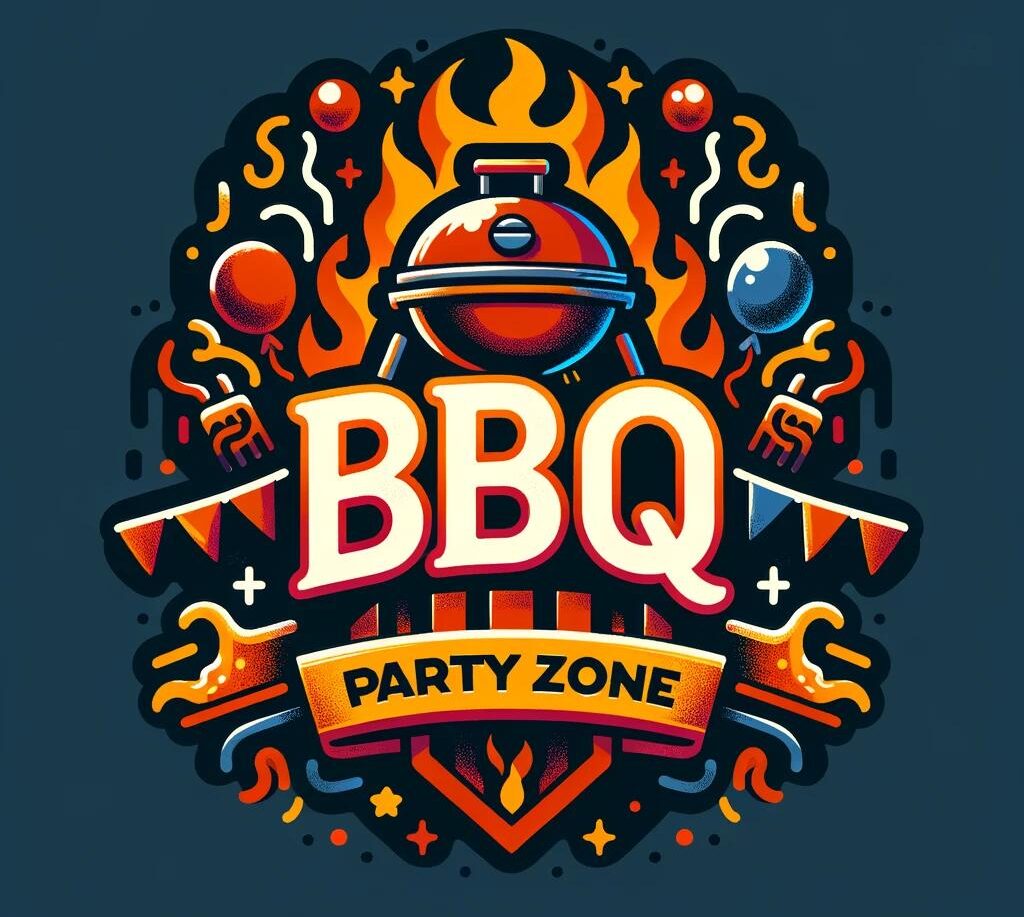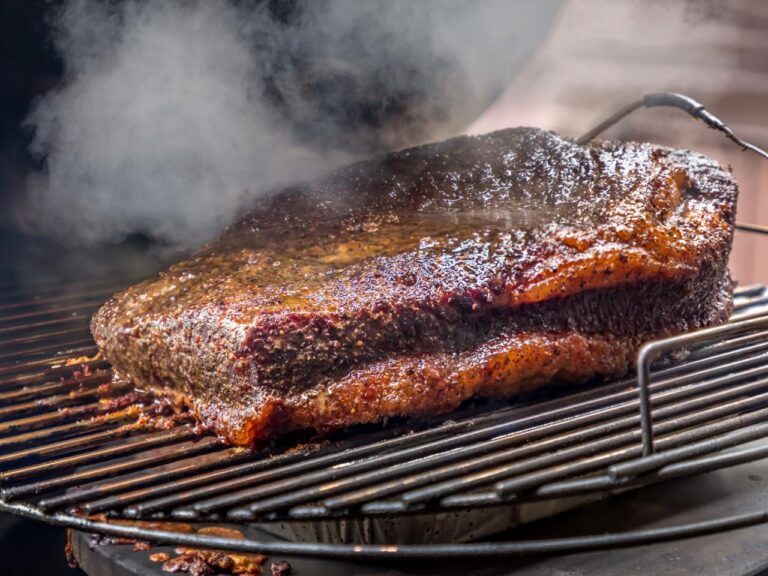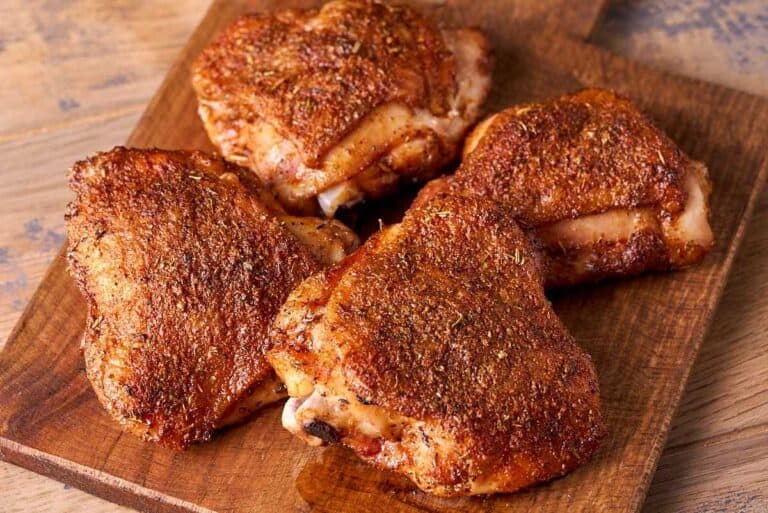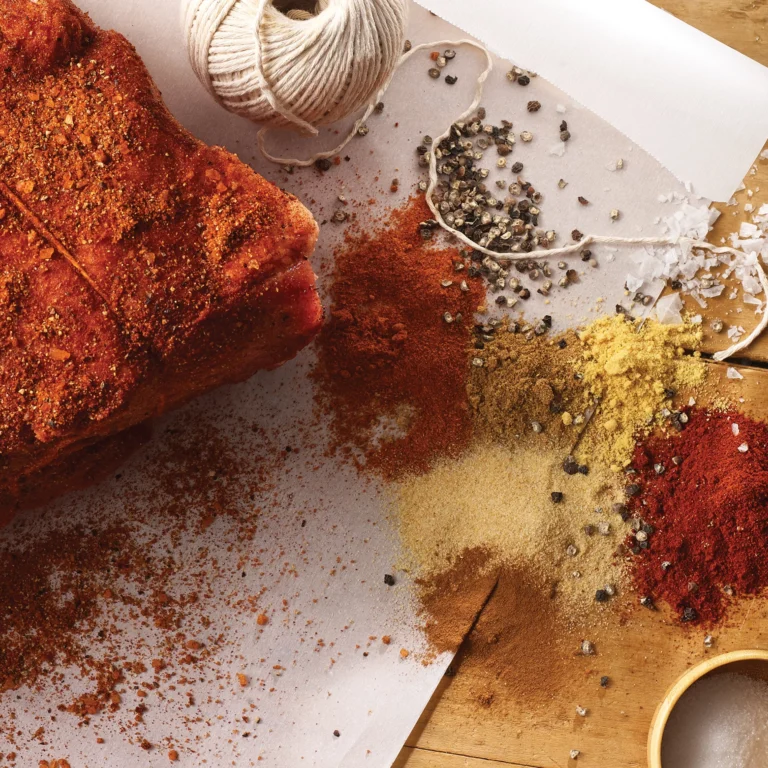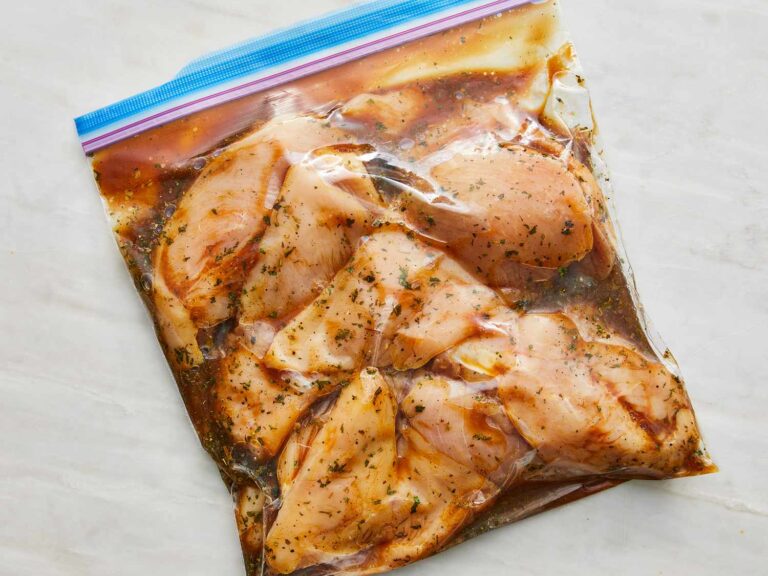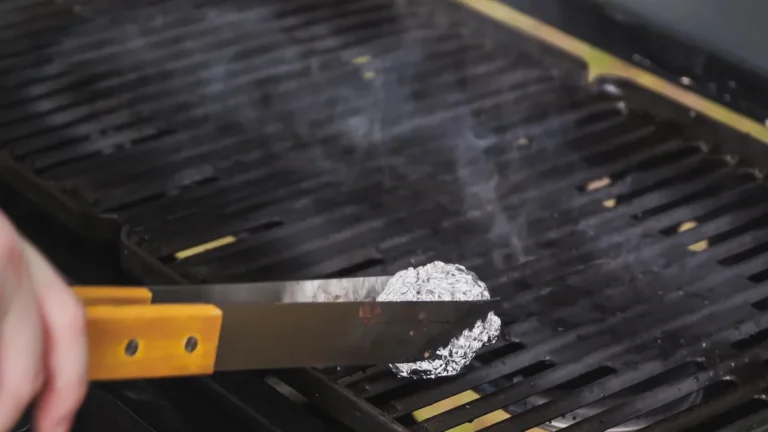Chopped BBQ Brisket Flat or Point: Which One is Better?
Torn between the brisket flat and the point? You’re stepping into a BBQ battlefield where each cut brings its own flair to the grill. This isn’t merely about choosing your dinner; it’s about picking a side in the epic saga of taste and texture. Are you leaning towards the lean and mighty flat, or does the rich and tender point call your name? Dive into this smoky debate armed with an appetite for discovery about Chopped BBQ Brisket Flat or Point. It’s time to explore, compare, and ultimately, cast your vote. Let the brisket battle begin!
What is a Brisket?
In its simplest form, brisket is a beef cut from the cow’s breast or lower chest. With the significant amount of weight and activity bearing on this region, there is a greater concentration of connective tissue and a denser muscle structure. This accurate structure reflects the beauty and difficulty of making brisket.
Brisket preparation requires precision and patience. The classic low-and-slow cooking techniques, such as roasting or smoking, are almost like rituals that turn this rough cut into something soft and tasty. This change is a gradual disintegration of the connective tissues that produce a very satisfying texture and flavor at the proper temperature and time.

To appreciate the harmony of temperature, time, and technique is to understand brisket. This cut does more than just provide nourishment—it also narrates a tale of custom, endurance, and culinary skill. Brisket, in all its complexity and richness, gives a profoundly human connection to the craft of cooking, whether it’s the star of a BBQ pitmaster’s menu or the focal point of a family get-together.
What are the Two Types of Brisket?
The popular and adaptable beef cut known as brisket is usually separated into two categories: the flat and the point. Every component of the brisket cut has distinct qualities and culinary applications.
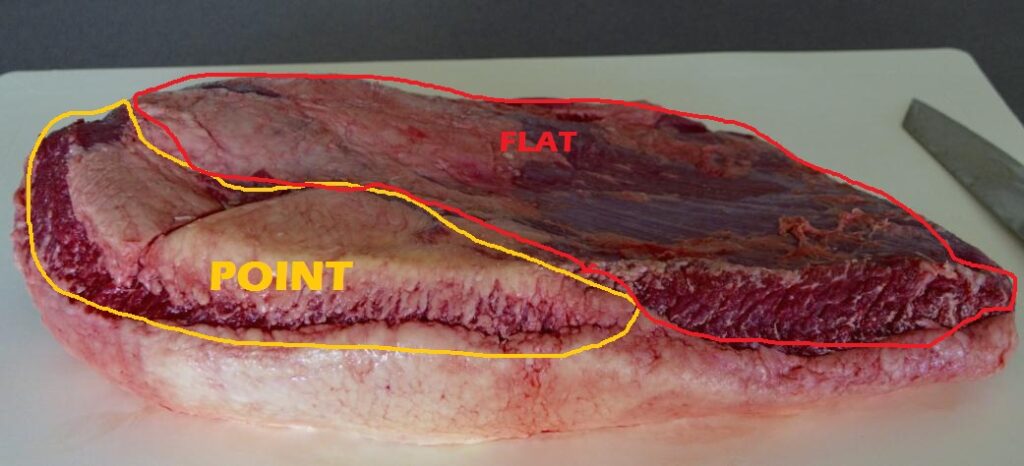
The Flat:
The slimmer part of the brisket is called the Flat, sometimes referred to as the First Cut or Flat Cut. Its shape is more homogeneous, and there is less fat marbling. When making recipes that call for nice, even slices, such as traditional deli-style sandwiches, the flat is frequently recommended. Because of its lean nature, preparing it carefully is necessary to keep it soft and juicy. If you want a beef cut that is tasty but leaner, this is a fantastic option.
The Point:
The point is fatter, thicker, and more marbled with fat than the flat. It is also referred to as the Second Cut, Point Cut, or Deckle. Due of the higher fat content, this region is renowned for its rich flavor and tender texture. When creating chopped brisket, the point is frequently utilized since the fat renders down during cooking, giving the meat juiciness and a powerful flavor. It’s a great option for recipes that call for a meat that is more delicious and succulent, such as BBQ brisket.
The decision between a flat and a point brisket frequently comes down to your preferred cooking style and ultimate result. Because the meat in the flat is thinner, it can be harder to cook to perfection, but the results can be elegantly sliced servings. The point is more forgiving when cooked due to its marbling and fat, making it perfect for recipes that call for a juicy, tender, and tasty meat.

Both cuts are highly valued, but for distinct recipes and for different reasons in barbecue culture. The point is prized for its rich, juicy, and savory properties, especially in chopped or shredded recipes, while the flat is frequently preferred for its presentation and slicing capability.
What Does Chopped Brisket Mean?
Chopped brisket refers to a specific way of preparing and serving brisket, a cut of beef from the cow’s lower chest. After being slow-cooked through methods like smoking or braising, which tenderizes and infuses it with flavor, the brisket is then chopped into small pieces.
This chopping can be done with various tools like
knives or cleavers. The resulting small, bite-sized pieces are known for their rich flavor and juiciness, as the process blends the meat with its fat and seasoned outer crust.

Chopped brisket is versatile in serving options, popular in BBQ sandwiches, tacos, or as a component of a hearty plate, often enjoyed with complementary sides. It’s especially favored for its ability to absorb additional sauces or seasonings, offering a delectable, flavor-rich eating experience.
What is the Difference Between Brisket and Chopped Brisket?
Chopped BBQ Brisket Flat or Point: The main difference lies in preparation and presentation. Brisket refers to the cut of beef from the cow’s lower chest, renowned for its rich flavor after slow cooking methods like smoking or braising. It’s often served sliced, showcasing its texture and layers.
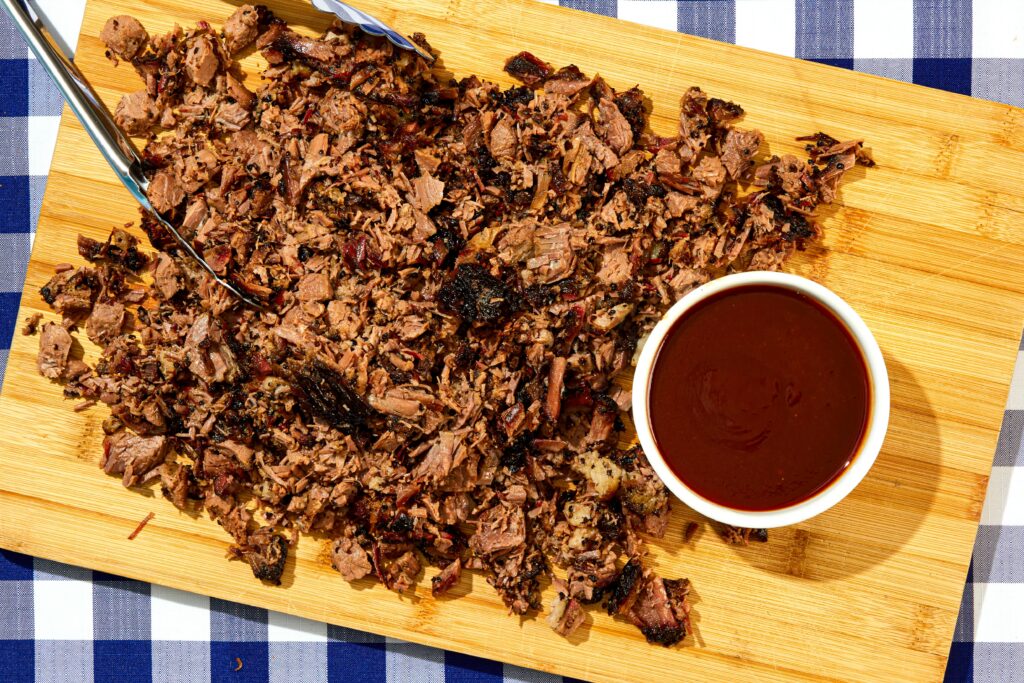
Chopped brisket, on the other hand, is this same cut, but after cooking, it’s chopped into smaller pieces. This method is especially popular in BBQ cuisine. Chopped brisket, typically juicier and more flavor-packed due to the mixing of fat, meat, and seasoned crust, is ideal for sandwiches, tacos, or as a hearty meal component. The choice between the two usually depends on personal taste and the desired culinary experience.
When to Use Chopped BBQ Brisket Flat and Point?
Using Chopped BBQ Brisket Flat vs. Point: It depends on the dish’s desired texture and flavor.
Chopped Brisket Flat: Use it when you want a leaner, slightly firmer texture in your dish. It’s ideal for dishes where you want the brisket to hold its shape a bit more, like in salads or wraps. The flat, being less fatty, absorbs sauces well without becoming too heavy.
Chopped Brisket Point: Opt for the point when you’re looking for richer, more succulent flavors. Its higher fat content renders into tender, flavorful pieces perfect for hearty dishes like sandwiches, tacos, or loaded nachos. The point’s juiciness enhances any dish where a moist, robust meat is desired.

Your choice should align with the overall profile you want in your meal – leaner and firmer with the flat, or richer and more tender with the point.
Which is Better for Chopped BBQ Brisket Flat or Point
Generally, the point cut works best for Chopped BBQ Brisket. This is the reason why:
- Greater Fat Content: The point contains a higher fat content, which renders down during cooking to produce a more flavorful, juicy outcome. This is essential for chopped BBQ brisket because the fat gives the chopped pieces moisture and richness.
- Tender Texture: Because chopped brisket style is best suited for soft, easily chewable chunks, the point’s marbling ensures a tender texture.
- Taste Profile: The point’s richer, more flavorful beef complements the brash nature of barbecued food and holds up nicely to smoking and strong seasonings.
Although the flat is equally suitable, its leaner texture is less desirable for a dish such as chopped BBQ brisket, where rich taste and juiciness are essential. With its characteristics, the point is better suited to providing the juicy, savory sensation that is usually sought in recipes with chopped BBQ brisket.
Reflecting on the discussion about brisket and its varieties, it’s clear that this beloved cut of beef offers incredible versatility. The distinction between the flat and point cuts is crucial, guiding chefs and BBQ enthusiasts in their culinary choices. The flat, with its leaner profile, is perfect for dishes requiring structured, neat slices. In contrast, the point, rich and marbled, is ideal for juicier, more flavorful preparations like chopped BBQ. Understanding these differences enhances one’s appreciation of brisket, allowing for tailored cooking methods to suit specific tastes and dishes. Brisket, in its complexity, truly embodies the art and science of cooking.
Conclusion
In conclusion, the world of brisket is a fascinating realm in culinary arts, offering a rich tapestry of flavors and textures. Understanding the distinct qualities of the flat and point cuts is essential for any brisket aficionado. The flat, lean and even, excels in dishes where structure and a less fatty profile are desired. Conversely, the point, with its marbling and richness, is the go-to for sumptuous, flavor-packed meals, especially in chopped BBQ preparations.
The choice between these cuts hinges on personal preference and the intended culinary creation. Brisket’s versatility, from smoking to braising, allows it to adapt beautifully to various cooking styles, reflecting the diversity and richness of culinary traditions. Whether you’re a seasoned pitmaster or a home cook, the journey of mastering brisket cooking is rewarding, elevating simple meals to memorable feasts. Brisket, in all its forms, truly is a testament to the wonders of cooking with patience and passion.
